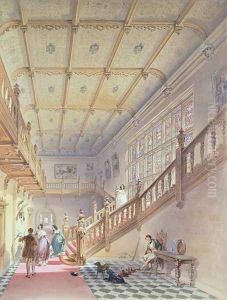William Railton Paintings
William Railton was an English architect, best known for designing the Nelson's Column in Trafalgar Square, London. Born in 1801, Railton was active during a period that saw the transition from the Georgian to the Victorian architectural styles. Though not as widely celebrated as some of his contemporaries, Railton made significant contributions to the architectural landscape of 19th-century Britain.
Railton began his career as an apprentice to John Buonarotti Papworth, a versatile architect and designer. Under Papworth's guidance, Railton honed his skills and cultivated an interest in classical architecture, which would later influence his design of the Nelson's Column. After his apprenticeship, Railton embarked on his professional journey, which was marked by a variety of projects, including country houses, churches, and other public buildings.
The commission for Nelson's Column came after the death of Admiral Horatio Nelson at the Battle of Trafalgar in 1805. A monument was desired to commemorate Nelson's victory and sacrifice. Railton's design was selected in a competition held in the 1830s. His design consisted of a Corinthian column topped by a statue of Nelson and flanked by four lions, although the lions were designed by Sir Edwin Landseer and added later. The column was completed in 1843 and remains a focal point of Trafalgar Square and a symbol of British naval power.
Aside from the Nelson's Column, Railton's architectural work included designs for the Southport Bathing House, extensions to the Rugby School, and numerous church buildings. His designs often reflected the eclectic tastes of the era, incorporating elements of the Gothic Revival and other revivalist styles.
William Railton's career was not without criticism; some contemporaries and later scholars considered his work somewhat derivative and lacking the innovation of architects like Augustus Pugin or Sir Charles Barry. Nonetheless, Railton's contributions to British architecture are still recognized, particularly through his most famous work, Nelson's Column. Railton passed away in 1877, leaving behind a legacy that, while perhaps not as prolific as some of his peers, includes one of London's most iconic landmarks.
